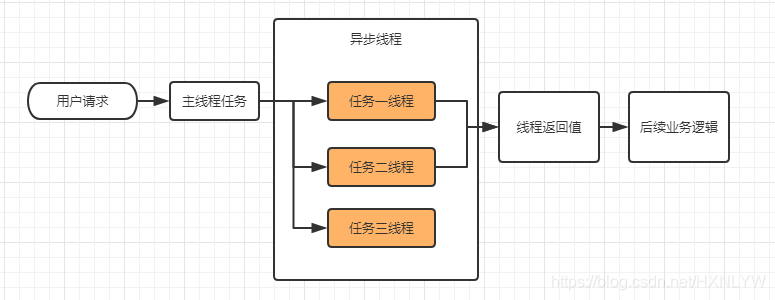版权声明:本文为博主原创文章,遵循 CC 4.0 BY-SA 版权协议,转载请附上原文出处链接和本声明。
前言:
异步在工作中越来越多的被使用到,比如:推送提醒、服务之间调用、数据同步等。最近我就遇到一个需求,【发布公告的时候需要调用第三方的接口发送短信】,这时我们就可以用异步实现短信发送,即可保证接口的响应速度,又可保证接口不受三方接口的超时、异常影响。
聊聊异步和同步:
同步:一件事一件事的做;【吃饭、睡觉、打豆豆】就是一个同步的过程;
异步:多件事一起做;【边吃边聊】就是一个异步的过程;
举得例子可能不太恰当,只是为了让大家更好的理解。下面我们就进入正题。
一、增加核心配置类:
@EnableAsync可加载启动类上,也可加载配置类上
import org.springframework.aop.interceptor.AsyncUncaughtExceptionHandler;
import org.springframework.context.annotation.Configuration;
import org.springframework.core.task.TaskDecorator;
import org.springframework.scheduling.annotation.AsyncConfigurer;
import org.springframework.scheduling.annotation.EnableAsync;
import org.springframework.scheduling.concurrent.ThreadPoolTaskExecutor;
import org.springframework.web.context.request.RequestAttributes;
import org.springframework.web.context.request.RequestContextHolder;
import java.util.concurrent.Executor;
import java.util.concurrent.ThreadPoolExecutor;
/**
* 异步线程池配置
*
* @author gourd
*/
@Configuration
@EnableAsync
public class TaskPoolConfig implements AsyncConfigurer {
@Override
public Executor getAsyncExecutor() {
ThreadPoolTaskExecutor executor = new ThreadPoolTaskExecutor();
// 核心线程数(默认线程数)
executor.setCorePoolSize(10);
// 最大线程数
executor.setMaxPoolSize(20);
// 缓冲队列数
executor.setQueueCapacity(200);
// 允许线程空闲时间(单位:默认为秒)
executor.setKeepAliveSeconds(60);
// 线程池名前缀
executor.setThreadNamePrefix("taskExecutor-");
// 设置是否等待计划任务在关闭时完成
executor.setWaitForTasksToCompleteOnShutdown(true);
// 设置此执行器应该阻止的最大秒数
executor.setAwaitTerminationSeconds(60);
// 增加 TaskDecorator 属性的配置
executor.setTaskDecorator(new ContextDecorator());
// 线程池对拒绝任务的处理策略
executor.setRejectedExecutionHandler(new ThreadPoolExecutor.CallerRunsPolicy());
// 初始化
executor.initialize();
return executor;
}
@Override
public AsyncUncaughtExceptionHandler getAsyncUncaughtExceptionHandler() {
return null;
}
/**
* 任务装饰器
*/
class ContextDecorator implements TaskDecorator {
@Override
public Runnable decorate(Runnable runnable) {
RequestAttributes context = RequestContextHolder.currentRequestAttributes();
return () -> {
try {
RequestContextHolder.setRequestAttributes(context);
runnable.run();
} finally {
RequestContextHolder.resetRequestAttributes();
}
};
}
}
}
二、service业务逻辑:
import com.gourd.common.data.BaseResponse;
import java.util.concurrent.Future;
/**
* @author gourd
*/
public interface AsyncService {
/**
* 任务一(有返回结果)
*
* @return
*/
Future<BaseResponse> doTaskOne();
/**
* 任务二(有返回结果)
*
* @return
*/
Future<BaseResponse> doTaskTwo();
/**
* 任务三(无返回结果)
*
* @return
*/
void doTaskThree() ;
}
import com.gourd.common.async.service.AsyncService;
import com.gourd.common.data.BaseResponse;
import com.gourd.common.utils.RequestHolder;
import lombok.extern.slf4j.Slf4j;
import org.springframework.scheduling.annotation.Async;
import org.springframework.scheduling.annotation.AsyncResult;
import org.springframework.stereotype.Service;
import javax.servlet.http.HttpServletRequest;
import java.util.concurrent.Future;
/**
* @author gourd
*/
@Service
@Slf4j
public class AsyncServiceImpl implements AsyncService {
@Override
@Async
public Future<BaseResponse> doTaskOne() {
log.info("开始做任务一(睡眠2s)");
methodThread();
HttpServletRequest request = RequestHolder.getRequest();
log.info("任务一完成,当前线程为 {},请求方法为 {},请求路径为:{}", Thread.currentThread().getName(), request.getMethod(), request.getRequestURL().toString());
return new AsyncResult<>(BaseResponse.ok("任务一完成"));
}
@Override
@Async
public Future<BaseResponse> doTaskTwo(){
log.info("开始做任务二(睡眠2s)");
methodThread();
HttpServletRequest request = RequestHolder.getRequest();
log.info("任务二完成,当前线程为 {},请求方法为 {},请求路径为:{}", Thread.currentThread().getName(), request.getMethod(), request.getRequestURL().toString());
return new AsyncResult<>(BaseResponse.ok("任务二完成"));
}
@Override
@Async
public void doTaskThree() {
log.info("开始做任务三(睡眠1s)");
try {
Thread.sleep(1000);
} catch (InterruptedException e) {
Thread.interrupted();
log.error("sleep异常:{}", e);
}
HttpServletRequest request = RequestHolder.getRequest();
log.info("任务三完成,当前线程为 {},请求方法为 {},请求路径为:{}", Thread.currentThread().getName(), request.getMethod(), request.getRequestURL().toString());
}
/**
* 接口睡眠
*/
private void methodThread() {
try {
Thread.sleep(2000);
} catch (InterruptedException e) {
Thread.interrupted();
log.error("sleep异常:{}", e);
}
}
}
BaseResponse实体类:
import lombok.Data;
import org.springframework.http.HttpStatus;
import java.io.Serializable;
/**
* @Author: gourd
* @Description:
* @Date:Created in 2018/8/27 16:19.
*/
@Data
public class BaseResponse<T> implements Serializable {
private int code;
private String msg;
private T data;
private String token;
public BaseResponse() {
}
public BaseResponse(int code, String msg, T data, String token) {
this.code = code;
this.msg = msg;
this.data = data;
this.token = token;
}
public BaseResponse(int code, String msg, T data) {
this.code = code;
this.msg = msg;
this.data = data;
}
public BaseResponse(int code, String msg) {
this.code = code;
this.msg = msg;
}
public BaseResponse(int code, String msg, String token) {
this.code = code;
this.msg = msg;
this.token = token;
}
public static BaseResponse ok(Object o) {
return new BaseResponse(HttpStatus.OK.value(), HttpStatus.OK.getReasonPhrase(),o);
}
public static BaseResponse ok(String msg) {
return new BaseResponse(HttpStatus.OK.value(), msg);
}
public static BaseResponse ok(String msg,Object o) {
return new BaseResponse(HttpStatus.OK.value(), msg,o);
}
public static BaseResponse failure(String msg) {
return new BaseResponse(HttpStatus.INTERNAL_SERVER_ERROR.value(), msg);
}
public static BaseResponse failure( Object o) {
return new BaseResponse(HttpStatus.BAD_REQUEST.value(), HttpStatus.INTERNAL_SERVER_ERROR.getReasonPhrase(),o);
}
}三、Controller接口测试,集成了Swagger:
import com.gourd.common.async.service.AsyncService;
import com.gourd.common.data.BaseResponse;
import io.swagger.annotations.Api;
import io.swagger.annotations.ApiOperation;
import lombok.extern.slf4j.Slf4j;
import org.springframework.beans.factory.annotation.Autowired;
import org.springframework.web.bind.annotation.GetMapping;
import org.springframework.web.bind.annotation.RequestMapping;
import org.springframework.web.bind.annotation.RestController;
import java.util.concurrent.Future;
/**
* @author gourd
* createAt: 2018/9/17
*/
@RestController
@Api(tags = "async",description = "异步任务控制器")
@RequestMapping("/async")
@Slf4j
public class AsyncTaskController {
@Autowired
private AsyncService asyncService;
@GetMapping(value = "/task" )
@ApiOperation(value = "异步任务控制器", notes = "异步任务控制器")
public BaseResponse taskExecute(){
long startTime = System.currentTimeMillis();
try {
Future<BaseResponse> r1 = asyncService.doTaskOne();
Future<BaseResponse> r2 = asyncService.doTaskTwo();
asyncService.doTaskThree();
while (true) {
if (r1.isDone() && r2.isDone()) {
log.info("异步任务一、二已完成");
break;
}
}
BaseResponse baseResponse1 = r1.get();
BaseResponse baseResponse2 = r2.get();
log.info("返回结果:{},{}",baseResponse1 , baseResponse2);
} catch (Exception e) {
log.error("执行异步任务异常 {}",e.getMessage());
}
long endTime = System.currentTimeMillis();
log.info("异步任务总耗时:{}",endTime-startTime);
return BaseResponse.ok("异步任务全部执行成功");
}
}
结果分析:
点击运行后的打印结果:

按正常同步的情况,应该是:【任务一】-> 【任务二】-> 【任务三】,且接口总耗时应该是2+2+1 = 5秒左右,但是实际的运行情况只有2秒左右,所以说明了三个任务是异步执行的。任务一和任务二是有返回值得所以用了一个while(true)监控两个任务都执行完后取到返回值,再去处理后续的逻辑。

案例来自自己的开源项目:https://blog.csdn.net/HXNLYW/article/details/98037354
结尾:
本文是最近实践异步多线程的一些总结和记录,如有不对的地方,欢迎评论吐槽。